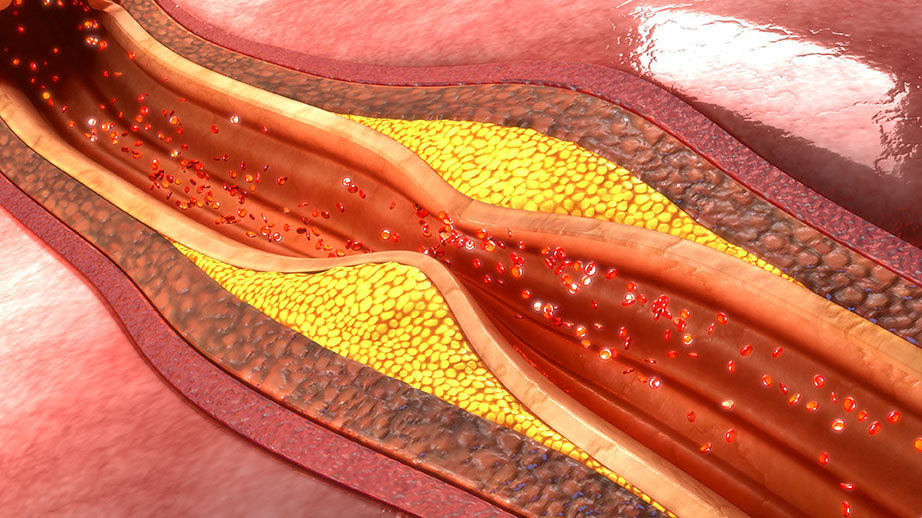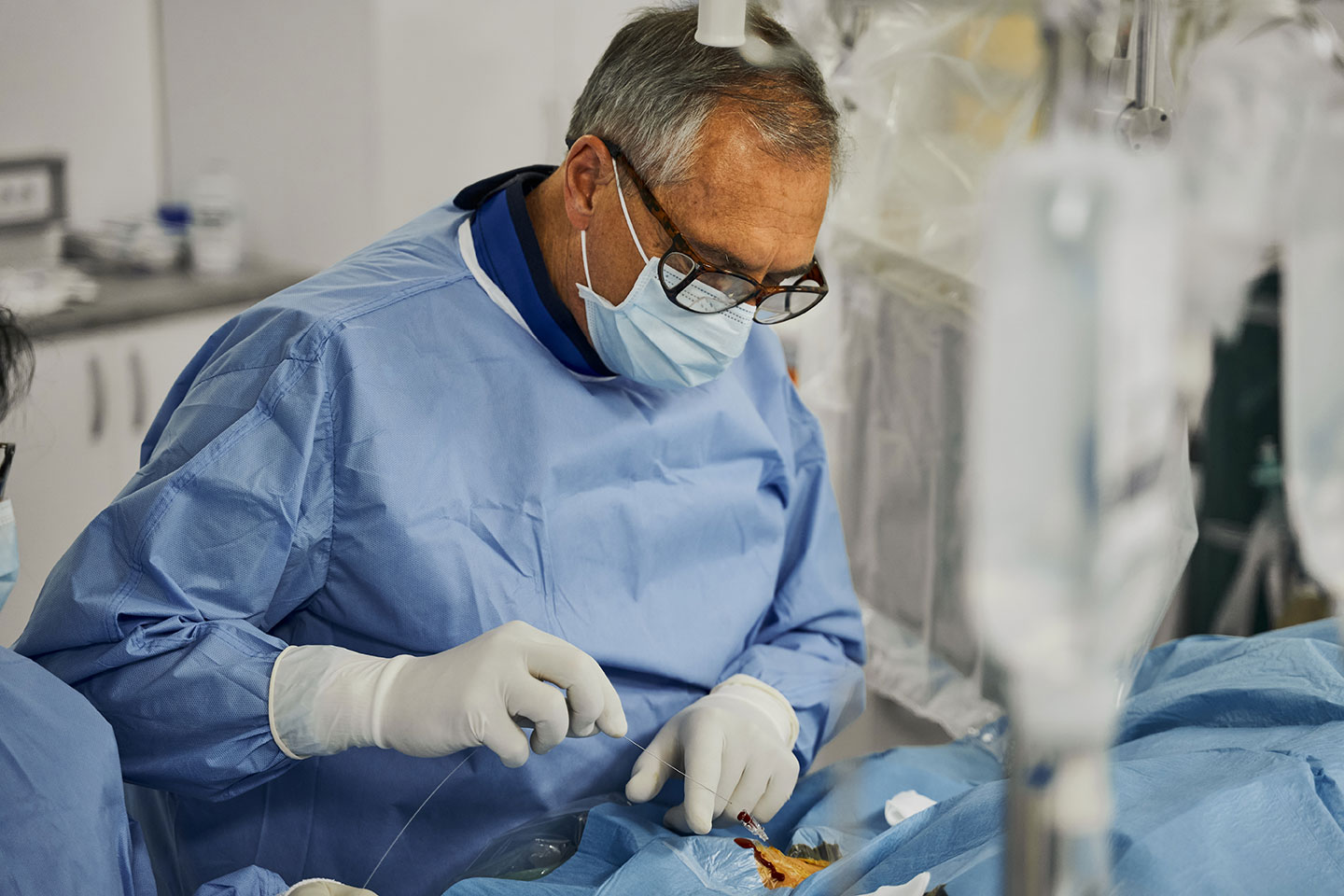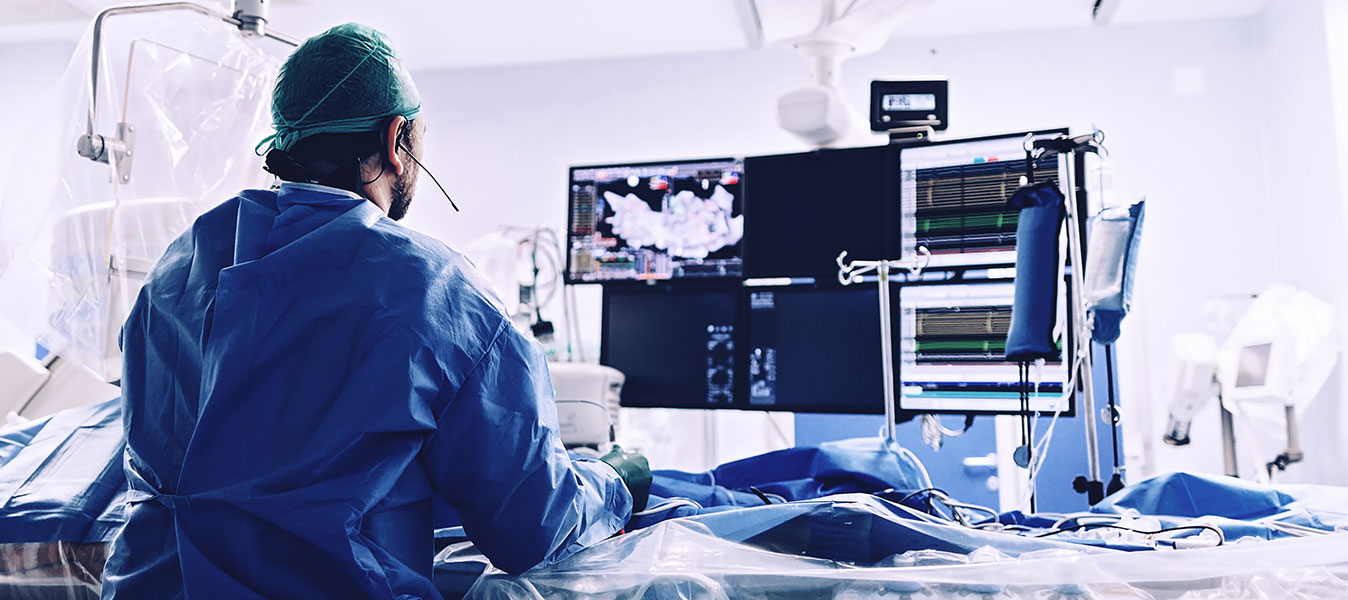Home » Services » Interventional procedures » Cardiac catheterization – coronary angiography
Cardiac Catheterization - Coronary Angiography
Cardiac catheterization or coronary angiography (coronarography) is a minimally invasive method of studying the heart and blood vessels that supply the heart (coronary arteries) without surgery. It usually involves imaging of the coronary arteries with X-rays using a technique called coronary angiography. The obtained images are coronary angiograms or arteriograms.
These tests are usually done when non-invasive tests (heart ultrasound, stress test, CT coronary angiography or calcium score) do not provide enough information, when non-invasive tests suggest a heart or blood vessel problem, or when a person has symptoms that cause a heart or coronary artery problem very likely. One of the advantages of this procedure is that doctors can also treat various diseases during diagnostic coronary angiography, including coronary artery disease.

Coronary artery disease is a narrowing or blockage of the coronary (heart) arteries. Your coronary arteries are in the form of hollow tubes through which blood can flow freely. The walls of the coronary arteries are usually smooth and elastic. Atherosclerosis occurs when the normal lining of the arteries worsens, the walls of the arteries thicken and deposits of fat accumulate on the walls of the coronary arteries, blocking or restricting the flow of oxygen-rich blood to the heart muscle.
Without adequate blood, the heart is left without oxygen and vital nutrients needed for proper functioning. This can cause chest pain called angina. When one or more coronary arteries are completely blocked, a heart attack can occur.
After the interventional procedure of cardiac catheterization, the coronary artery is opened, increasing the blood flow to the heart.
Cardiac catheterization is a relatively safe procedure and complications are rare.
When is cardiac catheterization required?
Cardiac catheterization – coronary angiography can be used to diagnose and treat heart disease and disorders, planning future treatments and perform certain procedures. This procedure is the only way to directly measure the blood pressure in each chamber of the heart and in the main blood vessels that go from the heart to the lungs.
Cardiac catheterization can be used:
- after a heart attack – where the heart blood is blocked
- measuring the amount of blood the heart pumps per minute
- detection of congenital heart defects
- detection and biopsy of tumors that affect the heart (for example, myxoma).
- to help diagnose angina – where chest pain is caused by limited blood supply to the heart
- planning an intervention or surgical procedure – such as coronary angioplasty, where narrowed or clogged blood vessels dilate
- the best method for diagnosing coronary heart disease, where the accumulation of fatty substances in the coronary arteries affects the heart’s blood supply

Interventional procedures at the Pulse Cardiology Center
An interventional procedure is a non-surgical treatment used to open narrowed coronary arteries to improve blood flow to the heart. An interventional procedure may be performed during diagnostic cardiac catheterization when a blockage is found or may be scheduled after catheterization confirms the presence of coronary artery disease.
The interventional procedure begins in the same way as cardiac catheterization. Once the catheter is placed, one of these interventional procedures is performed to open the artery: balloon angioplasty or stent placement.
How is cardiac catheterization performed
From the hospital ward where you are accommodated and prepared for cardiac catheterization, you will be transferred to the specially equipped Cath-lab of the Pulse Cardiology Center, where all interventional procedures are performed. A doctor (interventional cardiologist or radiologist) who is specially trained for such procedures performs the procedure with a team of nurses, technicians and anesthesiologists.
The nurse will clean and shave the area – the field where doctor will be working. This is usually in the area of the arm or groin. Before the coronary angiography procedure, the nurse will put an IV (intravenous) line in a vein in your arm so that you can get a medicine (sedative) to help you relax, but you will be awake and able to follow the instructions during the procedure.
The area where the catheter is inserted – puncture site, will be under the action of a local anesthetic. Local anesthesia very quickly “dulls” the catheter insertion site so you should not feel any discomfort. The doctor will then make an opening by inserting a needle through the skin into a large blood vessel.
During the procedure of cardiac catheterization – coronarography, a thin catheter (long, flexible, hollow, plastic tube) is inserted into an artery or vein in the neck, arm or groin, through an opening that was previously made with a needle.
The doctor will guide the catheter gently and carefully (a long, thin tube) into your blood vessel. The video screen will show the position of the catheter as it is passed through the main blood vessels to the heart. You may feel pressure in your groin, but you should not feel any pain.
A special type of dye called contrast material is injected through the catheter and X-rays (angiograms) are taken. Contrast material is visible on the angiograms, showing the blood vessels through which the fluid travels. This clearly highlights any blood vessels that are narrowed or clogged. Using X-rays as a guide, catheter tip passes to the heart and coronary arteries.
Diagnostic coronary angiography
Various small instruments can be passed through the tube to the tip of the catheter. They include instruments for measuring blood pressure in each heart chamber and in the blood vessels connected to the heart, for examining or taking ultrasound images of the inside of blood vessels, for taking blood samples from different parts of the heart or for taking tissue samples from the heart for examination under a microscope (biopsy).
- When a radiopaque contrast agent that can be seen on an X-ray is injected with a catheter, the procedure is called coronary angiography
- When a catheter is used to clean a narrowed or clogged artery, the procedure is called angioplasty or percutaneous coronary intervention (PCI).
- When a catheter is used to dilate a narrowed heart valve opening, the procedure is called valvuloplasty.
After the intervention, the doctor will remove the catheter. The nurse will apply pressure to the site through which the catheter was inserted, to prevent bleeding. Sometimes a special closing device is used.
The cardiac catheterization procedure lasts approximately 40 to 60 minutes, depending on whether only diagnostics will be performed or intervention (dilation, stenting) will also be performed.

Catheterization can be performed on the right or left side of the heart
Catheterization of the right side of the heart
Catheterization of the right side of the heart is done to obtain information about the heart chambers on the right side (right atrium and right ventricle) and the tricuspid valve (located between these two chambers) and evaluate the amount of blood the heart is pumping. The right atrium receives oxygen-depleted blood from the veins of the body, and the right ventricle pumps the blood into the lungs, where blood takes up oxygen and drops off carbon dioxide. In this procedure, the catheter is inserted into a vein, usually in the neck, arm, or the groin. Pulmonary artery catheterization , in which a balloon at the catheter’s tip is passed through the right atrium and ventricle and lodged in the pulmonary artery, is sometimes done during catheterization of the right side of the heart during certain major operations and in intensive care units. Right-side catheterization is used to detect and quantify heart function and abnormal connections between the right and left sides of the heart. Doctors also use right-side catheterization when evaluating people for heart transplantation or placing a mechanical device to help pump blood or for diagnosing and treating pulmonary hypertension or heart failure.
Catheterization of the left side of the heart
Catheterization of the left side of the heart is done to obtain information about the heart chambers on the left side (left atrium and left ventricle), the mitral valve (located between the left atrium and left ventricle), and the aortic valve (located between the left ventricle and the aorta). The left atrium receives oxygen-rich blood from the lungs, and the left ventricle pumps the blood into the rest of the body. This procedure is usually combined with coronary angiography to obtain information about the coronary arteries.
After coronary angiography
After the heart catheterization from the Cath-lab, you will be transferred to the recovery room for a few hours. During this time you must lie flat. You will be asked to keep your foot in a horizontal position and you should not get out of bed for at least 3-4 hours. If you need to urinate, you will do so in a bowl while lying in bed. Staff will check the puncture site and if necessary pressure will be applied to that site to stop any bleeding.
During the recovery, we will monitor your condition non-stop: heart rate and other vital signs (pulse and blood pressure). Report any swelling, pain or bleeding at the injection site or if you have chest pain.
Before you leave the hospital, you will receive written instructions on what to do at home.
You will usually be able to leave the hospital the same day after the diagnostic coronary angiography after a period of rest and observation. But if you have a stent implanted in the hospital at the same time, you will stay overnight.
Most people do not feel any changes the day after the procedure, although after this procedure you may feel a little tired, and the wound site will probably be sensitive for up to a week. Any bruise can last for several weeks. You will usually be advised to avoid certain activities, such as swimming, driving and lifting heavy objects, for a day or two after the procedure.
A responsible adult must take you home. You will not be discharged if you have not provided an escort who can take you home.
If you have more than two hours to drive home, we suggest taht you stay overnight at the hotel for your convenience. Then have a family member drive you home the next morning after you rest.
During the drive home, stop every hour and walk for 5 to 10 minutes. If you travel home by plane, get up to stretch your legs and walk down at least every hour. Please ask your doctor when you can continue driving.
After discharge and going home, be sure to follow all instructions carefully. It is important that you take your medication as directed by your doctor. You should seek medical attention immediately if the swelling at the site of your wound worsens or if you have excessive bleeding or problems with limb circulation.
Call a doctor immediately if:
The leg with puncture site is numb or constantly tingles or your foot is cold or blue.
- The area around the puncture site has large bruises.
- The puncture site swells or leaks fluid.
- The puncture site swells very quickly.
- Bleeding at the puncture site does not slow down when you press firmly on the puncture site.
How to prepare for cardiac catheterization
You will receive instructions on what to eat and drink during the 24 hours before the catheterization of the heart. You will usually be asked not to eat or drink for six to eight hours before the catheterization procedure.
Tell your doctor about any medications (including over-the-counter medications, herbs, and vitamins) you are taking. Your doctor may ask you not to take them before the intervention. Do not stop taking the therapy until your doctor tells you to.
Tell your doctor or nurse if you are allergic to anything, especially iodine, seafood – shellfish, latex or rubber products, medicines like penicillin or X-rays colors.
Arrange for someone to drive you home after the procedure.
If you wear a hearing aid, wear it during the procedure. The denture needs to be removed before the intervention. If you wear glasses, take them with you to the hospital.
Complications and risks of coronary angiography
Cardiac catheterization – coronary angiography is usually a very safe intervention. A small number of patients have fewer problems. In some, bruises appear at the site where the catheter was inserted (puncture site). The contrast material due to which the arteries are shown on X-rays leads to some patients feeling stomach problems, itching or developing a rash.
As with all procedures, there are some risks, including:
- allergy to a contrast material – this is not common but before you start the procedure, you should discuss all the allergies you have with your cardiologist
- bleeding under the skin where the catheter was inserted – this should stop after a few days, but if you are worried, see a doctor
- very low risk of more serious complications, including damage to the artery in the arm or leg where the catheter was inserted, heart attack, stroke, kidney damage and, very rarely, death
The cost of cardiac catheterization
Diagnostic coronarography price – 95.000 din.
Coronarography with dilation – 110.000 din.
Coronarography with 1 stent implanted price – 250.000 din.
Each subsequent stent implanted price – 95.000 din.
Cardiac catheterization at the Pulse Cardiology Center
Cardiac catheterization is performed in a specially equipped Cath-lab by experts in interventional cardiology and radiology. Take a look at our team and schedule an appointment. Our call center is available every day until 8 pm on 0117555000 if you have additional questions. You can also contact us via email: info@pulskardioloskicentar.rs
